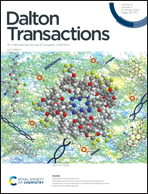Photophysicochemical, sonochemical, and biological properties of novel hexadeca-substituted phthalocyanines bearing fluorinated groups†
Abstract
This study presents the preparation of a novel tetra-substituted phthalonitrile (1), namely, 3,6-bis(hexyloxy)-4,5-bis(4-(trifluoromethoxy)phenoxy)phthalonitrile (1) and its metal-free (2)/metal {M = Zn (3), Cu (4), Co (5), Lu(CH3COO) (6), Lu (7)} phthalocyanines. A series of various spectroscopic methods (UV-vis, FT-IR, mass, and 1H NMR spectroscopy) were performed for the characterization of the newly synthesized compounds. The potential of compounds 2, 3, and 6 as photosensitizing materials for photodynamic and sonophotodynamic therapies was evaluated by photophysical, photochemical, and sonochemical methods. The highest singlet quantum yields were obtained for the zinc phthalocyanine derivative 3 by performing photochemical and sonochemical methods. In addition, several biological activities of the new compounds 1–7 were investigated. The newly synthesized phthalocyanines exhibited excellent DPPH scavenging activity and also DNA nuclease activity. The antimicrobial activity of the new compounds was evaluated by the disc diffusion assay. Effective microbial cell viability inhibition was observed with phthalocyanine macromolecules. The photodynamic antimicrobial therapy of the phthalocyanines showed 100% bacterial inhibition when compared to the control. They also exhibited significant biofilm inhibition activity against S. aureus and P. aeruginosa. These results indicate that new phthalocyanines are promising photodynamic antimicrobial therapies for the treatment of infectious diseases.



 Please wait while we load your content...
Please wait while we load your content...